Food Travellers: The Ultimate Guide to Culinary Adventures Around the World
A friendly guide for food travellers—planning tips, must-try experiences, smart budgeting, and cultural know-how to eat well anywhere.
If you’ve ever booked a flight because a friend said, “You have to try the noodles there,” you’re already one of the food travellers. We’re the people who build itineraries around markets, cooking classes, and “that tiny spot locals swear by.” I still remember the first time I felt like a true food traveller: jet-lagged in Osaka at 11 p.m., slurping ramen while the chef—who’d simmered the same broth for decades—gave me a nod that said, “You get it.” No translator needed. Food is the language.
In this guide, I’ll show you how food travellers plan smarter trips, find authentic eats (without gatekeeping secrets), and do it all in a way that’s respectful, budget-savvy, and actually fun. Expect practical checklists, a “first 48 hours” game plan, destination picks, street-smart safety tips, and a friendly nudge to go try that dish you’ve been avoiding. And yes, we’ll keep it real: some places are cash-only, your gut may occasionally revolt, and Google Translate will absolutely become your sidekick.
Before we dig in, let me share to you a quick note on credibility: the World Food Travel Association (WFTA) puts out an annual State of the Industry report with trends like authenticity, localism, sustainability, and the (still huge) role of social media in discovery—this is a useful context for food travellers like you who is now plotting the next bite. If you want the deeper industry view, you can grab their 2024 report for free on their site: WFTA 2024 State of the Industry and their research hub here: WFTA Annual/Research.
What You’ll Learn (and actually use)
- How food travellers pick destinations (and seasons) for peak flavor
- A “first 48 hours” playbook to hit the ground munching
- Street-smarts for markets, street food, and etiquette
- Budget tactics that don’t kill the joy
- A Dietary Needs Decoder with real phrases to use
- Handful of pinpoint recommendations in Tokyo, Bangkok, Oaxaca, Bologna, and Hanoi
- A clean, three-step call to action so you’ll actually go
What Makes Food Travellers Different
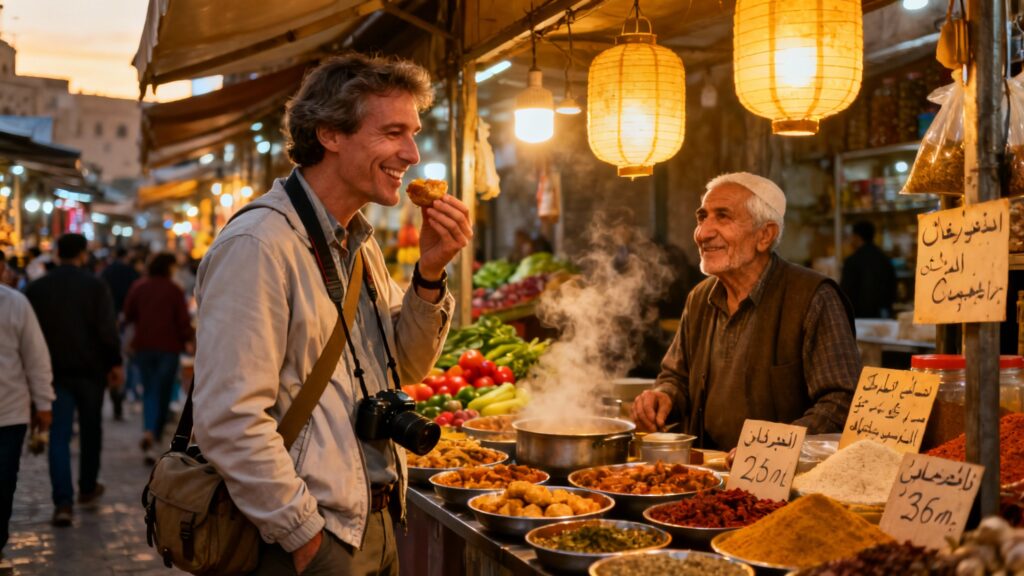
Food travellers don’t ask, “What’s the top attraction?” We ask, “What’s the dish I’ll think about in three years?” It’s curiosity with a fork. It’s caring how the sauce is made and why that family closes for two hours every day to rest the dough. It’s walking an extra fifteen minutes because the better dumpling shop is across the river (yep, I’ve done it in the rain—zero regrets).
Let me tell you this that distance is nothing when the palate is interested to discover why the food photos in the latest articles is screaming “try me or regret half of your life!”
Visitors like me would grab that next trip to the other side of the world just to taste that best selling siomai in Japan. It’s more than just curiosity, it’s the food traveller in me that yearns to learn the stories, history, and cultures of why the food has been passed on from generation to generation and still is being widely patronized by the locals.
A few shared traits:
- We chase authenticity over hype. Not because we’re snobs—because we’re here to learn.
- We plan just enough, then leave space for detours (that tiny cart with no sign usually wins).
- We respect the culture and the kitchen. If grandma says “eat with your right hand,” we do it.
- We use tech to discover and document, but we don’t let it rule the trip.
Speaking of trends, WFTA’s 2024 report spotlights recurring themes: travelers valuing authenticity, local producers, and sustainability—and yes, social media still nudges where we go and what we try. That aligns with what I’ve seen on the ground: a busy stall with no English menu beats a “Top 10 Tourist Eats” list nine times out of ten. Source: WFTA 2024 State of the Industry.
The First 48 Hours: Your Food Travel Game Plan
Think of this as your flavor jumpstart. It’s simple, flexible, and it works in most cities.
Walk the neighborhood loop
I suggest you spend an hour roaming the blocks around your stay. Note 3–5 places buzzing with locals at different times of day. Snap pics of menus for later.
Bonus: Spot a morning bakery and a late-night snack option. You’ll thank yourself.
Make the market your HQ
Hit the main market on day one. Buy small tastes from multiple vendors: fruit you’ve never tried, a warm pastry, a local snack. From experience, this will allow you to imagine a broader picture of a place’s food culture.
Ask two questions at stalls: “What’s your specialty?” and “Where do you eat on your day off?”
Book one anchor experience
Lock in a cooking class, market tour, or food walk within your first two days. It orients your palate, teaches etiquette, and gives you a local friend.
Here’s my tip: If you are travelling in new cities, I suggest you join group walking tours. Another experience you want to jump in is trying out cooking classes for learning new techniques (think about that pasta in Bologna, or how they made those curry pastes in Chiang Mai).
Keep in mind the three must-try dishes
Make your list specific. Something like “Pho bo with rare beef in Hanoi’s Old Quarter,” and don’t just put “try Vietnamese food.”
Keep a simple list in Notes. I would use this style in my food travels: dish + neighborhood + backup spot.
Cash, translation, and transport
Get local currency for markets/street food; set up offline maps; add language cards for any dietary needs.
Practice 3 phrases: “What do you recommend?” “Thank you, it’s delicious.” “No [allergen/ingredient], please.”
I had this experience in one of my travels when I pretended I knew what was written in the menu and ended up ordering a spicy laksa – I mean I love heat but that level of spice almost turned my ears into a chocho train!
Choosing Where (and When) to Go
Food travellers love timing. The right month can turn a good trip into a euphoric one.
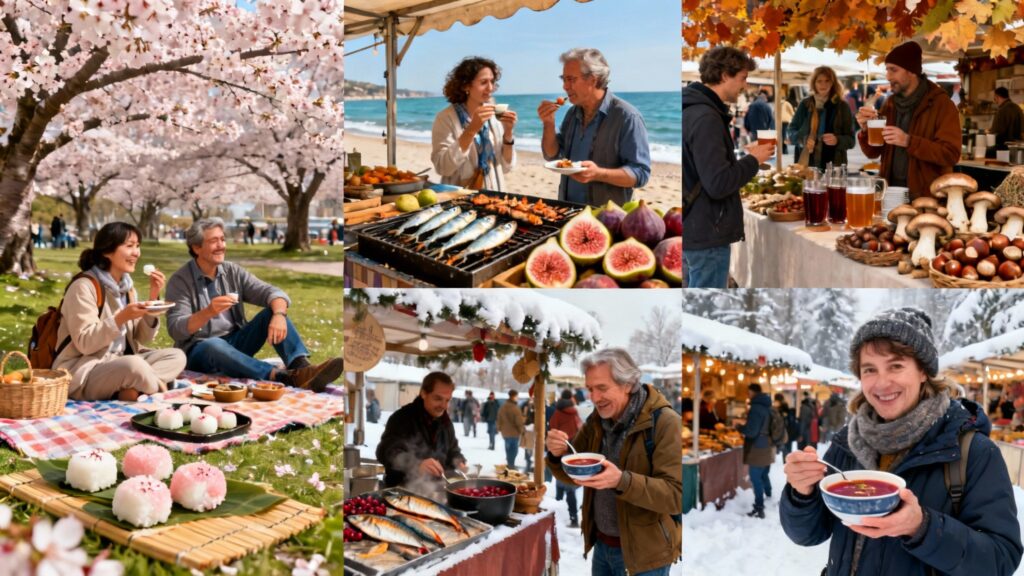
Seasonality matters
Italy’s white truffle season runs roughly October–December. In Japan, spring means fresh bamboo shoots and strawberries; autumn brings matsutake mushrooms and chestnuts.
I suggest you keep track on what’s in season so that you can sample fresh, limited-time dishes that are only available during their peak. That is definitely something you don’t want to miss in your food travels.
I had my first travel in Thailand in 2023 and I made sure that it was mango season. Guess what? Thailand’s fruit seasons transform markets— and their mango sticky rice during peak mango season? Chef’s kiss.
Festivals and limited runs
San Sebastián’s gastronomic calendar ramps up in early autumn; Oaxaca’s food scene glows during Guelaguetza (July) and Day of the Dead (late Oct–early Nov).
If you’re a coffee person, harvest periods in Colombia (varies by region) add tours and tastings that hit different.
Budget alignment
Southeast Asia and parts of Latin America: feast on $20–40/day for food. Western Europe and Japan: factor in $50–100/day, with big savings available via lunch sets and market meals.
Research the right way
I suggest you look past “Top 10” lists you find on Google. I normally use local food blogs, neighborhood hashtags, and niche platforms like Eatwith and Traveling Spoon for home-hosted meals and classes whenever I travel. I feel like they give more genuine information where your expectations and reality meet halfway.
For macro trends and inspiration, WFTA’s research hub is worth a skim: WFTA Research.
Street-Smarts for Food Travellers
This is the stuff that keeps your stomach (and reputation) happy.
Follow the turnover
A busy stall is a safe stall. The locals’ line is your North Star.
Read the setup
Clean boards and hot grills are green flags. Pre-cut meats slumped at room temp? I’ll pass. Don’t get me wrong, but no matter where I go, I make sure I’ll get home with my gut intact. I know some foods look so enticing, but do not be tempted so easily without checking how those foods are prepared.
Order small, order more
Try one dish; if it’s great, re-up. That way you sample broadly without committing to a dud.
I learned this the hard way. My friend Sean, and I, once had a trip to Hawaii. We had lunch in this certain restaurant and we decided to get whatever most of the restaurant’s customers were having. The portion was huge, but the taste was not what we expected. We don’t want to waste any food so we ate at least half of it.
Cash is king
Many top bites are cash-only. Keep small bills. Don’t be the person waving a card at a $2 cart.
Respect the rhythm
Some vendors sell one thing and sell out. Don’t ask for “special requests” that break their flow.
Learn micro-etiquette
Chopsticks vertical in rice is a funeral symbol in Japan (don’t do it). In many places, the left hand is avoided for eating. Watch and match.
Photograph politely
Ask with a smile or a gesture. If it’s swamped, eat first, shoot later.
The Dietary Needs Decoder (With Real Phrases)
Food travellers with dietary restrictions can—and should—eat well everywhere. Preparation is your superpower.
- Celiac/gluten-free
- Risk: Hidden soy sauce (contains wheat), cross-contamination.
- Safer cuisines: Many Mexican corn-based dishes; naturally GF Southeast Asian rice-based dishes (still watch sauces).
- Example phrases:
- Japanese: グルテンは食べられません。小麦粉・醤油は避けたいです。 (I can’t eat gluten. Please avoid wheat flour and soy sauce.)
- Spanish: Soy celíaco/a. No puedo comer gluten. Evite harina y salsa de soja, por favor.
- Thai: ฉันแพ้กลูเตน กรุณาเลี่ยงแป้งสาลีและซีอิ๊วครับ/ค่ะ
- Vegetarian/vegan
- Watch-outs: Fish sauce in Southeast Asia; lard in some European pastries; chicken stock in “vegetable” soups.
- Phrases:
- Japanese: ベジタリアンです。魚や肉のだしも避けたいです。 (I’m vegetarian. Please avoid fish/meat stock.)
- Spanish: Soy vegetariano/a. Sin caldo de carne ni pescado, por favor.
- Thai: ฉันเป็นมังสวิรัติ ไม่เอาน้ำสต๊อกเนื้อหรือปลา
- Halal/Kosher considerations
- Look for certification symbols, ask about separate prep surfaces, and seek neighborhoods with established communities (e.g., halal quarters, kosher bakeries).
- Phrases:
- Spanish: ¿La carne es halal? ¿Tienen certificación?
- Japanese: これはハラールですか? 証明はありますか?
Apps that help:
- HappyCow (veg/vegan), Spokin (allergies), and allergy translation card generators you can screenshot. Even a simple printed card works wonders.
Practical Packing for Food Travellers
- Pocket kit: Hand sanitizer, travel tissues, reusable chopsticks/spork, mint gum (your future self will applaud), a tiny salt/pepper if you’re that person.
- Tech: Offline maps, Google Translate with camera, note-taking app for dish/spot logs, local ride-hail app if available.
- Insurance: Not glamorous, but essential. I treat it like a helmet—hope to never use it, relieved when I need it.
Regional Highlights with Real-World Picks
I could write a book here (don’t tempt me), but these are strong starting points. They’re not fancy; they’re the places I send friends who ask, “Where should I actually go?”
Tokyo, Japan
- Why food travellers love it: Precision, seasonality, and a culture that takes pride in doing one thing perfectly.
- Try this:
- Rokurinsha (Tokyo Station): Tsukemen with a cult following; go early for shorter lines.
- Omoide Yokocho, Shinjuku: Yakitori alley that’s smoky, cozy, and very Tokyo-night.
- Depachika (department store food halls): Bento artistry and dessert heaven under one roof.
- Pro move: Book a sushi counter lunch set instead of dinner—same mastery, easier price.
Bangkok, Thailand
- Why food travellers love it: Street food PhD program disguised as a city. Specialists everywhere.
- Try this:
- Yaowarat (Chinatown) night crawl: Grills, noodles, and desserts in neon glow.
- Jay Fai: Famous crab omelet. Pricey for street food, unforgettable once.
- Or Tor Kor Market: Clean, curated market—great produce and ready-to-eat bites.
- Pro move: Take a market-and-cooking class in the morning; then retrace your teacher’s vendor map solo.
Oaxaca, Mexico
- Why food travellers love it: Deep traditions, mezcal culture, and moles that tell history.
- Try this:
- Mercado 20 de Noviembre: Tlayudas, moles, and the “smoke hall” for grilled meats.
- Los Danzantes (modern Oaxacan): A nice sit-down to balance market days.
- Mezcaloteca (tasting/education): Understand agave before you start “tasting” too much.
- Pro move: Ask vendors about seasonal chapulines (toasted grasshoppers). Lime and salt. Crunchy delight.
Bologna/Emilia-Romagna, Italy
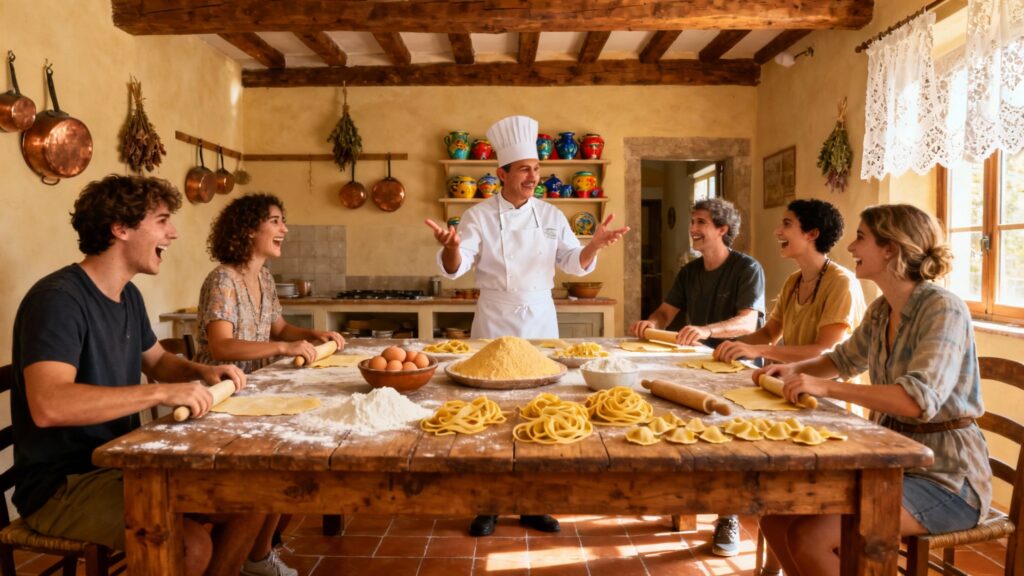
- Why food travellers love it: Technique, pasta traditions, and a sense that nonna is still judging (in a loving way).
- Try this:
- Trattoria di Via Serra: Honest, seasonal, and soul-warming.
- Mercato delle Erbe: Casual eats and great produce under one roof.
- Pasta workshop with a sfoglina: Learning to feel dough with your fingertips is the point.
- Pro move: Buy Parmigiano Reggiano with age and region info—taste side by side. You’ll never call them “all the same” again.
Hanoi, Vietnam
- Why food travellers love it: Breakfast-as-destination, broth theology, and herb-forward balance.
- Try this:
- Pho bo for breakfast in the Old Quarter: Pick a place with a fast-moving line and clean herbs.
- Bun cha (grilled pork with noodles): Smoky, bright, and habit-forming.
- Egg coffee café: Sweet, rich, and very Hanoi (order one to share if you’re unsure).
- Pro move: Spend a day trying pho from 2–3 places. Notice how the broth changes block by block. It’s a masterclass.
Budgeting Without Killing the Joy
Food travellers can eat well at any price point. The trick is timing and intent.
- Lunch sets > dinner splurges
- Many restaurants do weekday lunch deals that deliver 80–90% of the experience at 50–70% of the price.
- Build your day around one anchor meal
- Decide: street-food day or “nice dinner” day. Mix and match so you don’t drift into “four mediocre meals” territory.
- Share to multiply experiences
- Order 2–3 dishes for 2 people everywhere you go. More tastes, less waste, same spend.
- Region ballparks (food only, flexible by city and your appetite)
- Southeast Asia: $15–25/day
- Eastern Europe: $25–40/day
- Western Europe: $50–80/day
- Japan: $40–60/day
- U.S./Canada: $60–100/day
- Hidden savings
- Markets for breakfast, bakeries for mid-day, “happy hour” snacks at nicer places, and local set menus.
Health and Safety (Keeping Adventure, Not Regret)
- Hydration and water
- If tap water is questionable, use bottled for drinking and brushing. Go easy on ice unless you’re confident it’s purified.
- Pace yourself
- New spices + jet lag + enthusiasm is a combo. Give your stomach a runway.
- Basic kit
- Oral rehydration salts, antacid, a gentle stomach med, and probiotics. I carry a “mini pharmacy” so a great trip isn’t derailed by day three.
- Common sense with street food
- Repeat after me: high turnover, hot and fresh, clean prep surface. If you wouldn’t eat it at home, don’t make “I’m abroad!” your logic.
Add Real Cred: Use Sources That Matter
If you’re writing, planning professionally, or just nerding out, WFTA’s reports are an excellent pulse check on where culinary travel is going: authenticity, localism, sustainability, and the ongoing role of social platforms in discovery are core themes in 2024. You can download the latest summary report here: WFTA 2024 State of the Industry. Their broader research hub is here: WFTA Annual/Research. I like citing them because they’re the industry body for food tourism—so you’re not just quoting “some blog.”
Quick-Glance Checklist (Before You Go)
- Confirm seasonal specialties and any festivals
- Download offline maps + translation (camera mode)
- Save 2–3 local food blogs or threads per city
- Book one food anchor (class/tour) for Day 1–2
- Add dietary phrase cards to your phone (and print)
- Get local currency and small bills
- Screenshot your shortlist of dishes and venues
- Pack your pocket kit (sanitizer, tissues, utensils)
- Check insurance coverage (yes, boring, yes, do it)
FAQ for Food Travellers
- Are food tours worth it?
- If you’re new to a city or short on time, absolutely. You’re paying for curation, context, and a path through the noise. Small group sizes matter.
- How do I avoid getting sick from street food?
- Choose crowded stalls, order cooked-to-order dishes, and eat what locals are eating. Skip pre-cut meats sitting in the sun. Easy rule, big payoff.
- How do I vet cooking classes?
- Look for market components, small groups, and menus that match local staples (not just “tourist greatest hits”). Reviews should mention teaching, not just eating.
- What if I don’t speak the language?
- Smile, point, and use translation apps. Food is forgiving. People appreciate effort.
A Few Stories (Because Food Is Memory)
- Osaka, Japan
- The ramen shop at 11 p.m. was tiny, the broth was a secret, and the chef moved like a metronome. I didn’t know the words for “this tastes like home,” but he read it on my face. Food travellers chase that moment.
- Oaxaca, Mexico
- Chapulines were a dare until they weren’t. Lime, salt, crunch, and suddenly it was the perfect snack. The vendor laughed at my cautious nibble, then piled extra in my bag. I walked away happy and a little braver.
- Hanoi, Vietnam
- Day three of the pho sprint and I swear I could taste the personality of each broth—some lemony-bright, some deep and peppery. It felt like meeting families through soup.
Put It All Together: A 1-Day Sample Flow of My Recent Travel in Japan
Morning: I had a fresh fruit, a pastry, and a coffee where the regulars stand. My tip on shortlist refinement: pick your anchor meal and a dessert spot.
Midday: I stood and watched while a food vendor demonstrated how he made his local cuisine specialty. I told myself that learning one technique from this local vendor can help enhance my culinary skills at home.
Afternoon: I grabbed my journal and took time to reminisce my favorite tastes so I can create new and updated map pins.
Evening: Ah, my beloved smoky yakitori alley and the street foods that just keeps surprising your palate. I won’t gatekeep this because you’ll definitely love this
Night: A neighborhood walk and one final snack. Take a photo, but also just enjoy it. Your future self can Google the address.
The Food Travellers’ CTA (A Simple 3-Step Start)
- Pick a city you’ve been curious about (Hanoi, Tokyo, Oaxaca, Bologna, Bangkok—follow your gut).
- Pick three dishes you’ll hunt down. Be specific. Write them down.
- Book one food anchor (class, tour, or tasting) in the first two days.
That’s it. You’re in motion.
Closing Thoughts for Food Travellers
Food travellers aren’t just chasing “the best” bite. We’re chasing connection—stories told through simmering pots and shared tables. The best part? You don’t need a five-star budget or a spreadsheet the size of a novel. You need curiosity, a few street-smarts, and the willingness to say, “What do you recommend?”
If you want industry-level trends and validation for your inner nerd (no judgment, I’m that person too), the World Food Travel Association’s latest summary is a clean read: WFTA 2024 State of the Industry. It backs up what so many of us feel on the road: authenticity matters, local makers matter, and yes—your next unforgettable meal might be at a stall with a handwritten sign.
So, where to next? For food travellers, every trip is a delicious experiment. Pack your appetite, respect the kitchen, and leave room for a culinary surprise. The best dish of your life might still be ahead—probably down a side street, probably for less than you expect, and definitely worth the walk.

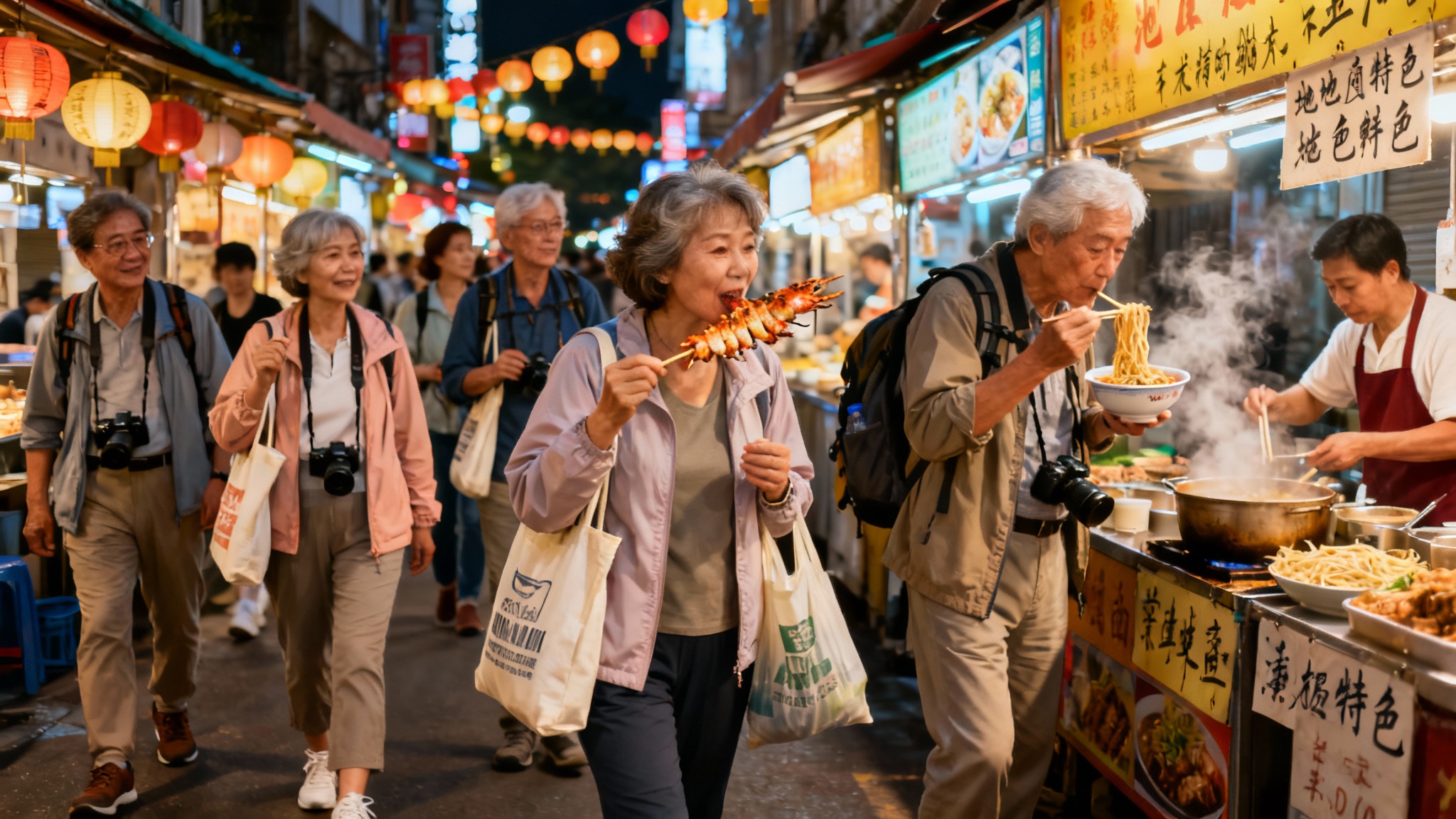





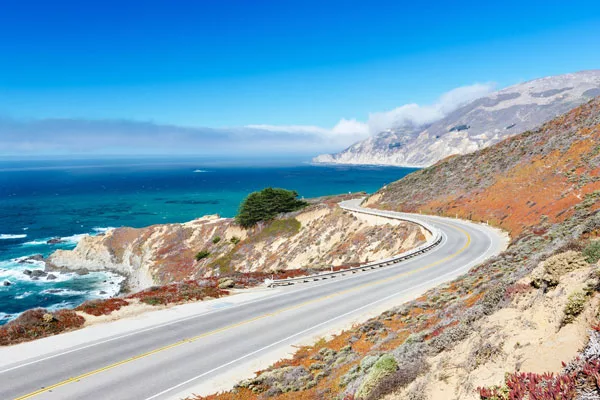
One Comment
Comments are closed.